How to Get Rid of Head Lice
HEAD LICE
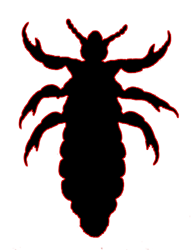 |
| Image 1: Head louse. |
Surprisingly, perhaps, head lice (Pediculus humanus capitis) are still a very common problem, particularly in schools and kindergartens. Contrary to popular belief, they are not a sign of uncleanness or poor hygiene. Anyone can get infected with this tiny parasite, however it is most often found in children from 3 to 12 years of age. Head lice are specialized to live on the human head. If you find lice on any other part of the body covered with hair, they are not head lice but a different type of sucking lice (pubic lice or body lice). Head lice are not dangerous, they don’t spread disease, but they are contagious and usually a very annoying problem.
DESCRIPTION
The adult louse is similar in appearance to a small ant and if looked at from the side it appears flat. Its body is no bigger than a sesame seed and is made up of three parts: head, thorax and abdomen. They have six legs, the front two being bigger with hook like claws so they can grab on to the hair. Adult lice are greyish brown colour. With their specially adapted mouths they pierce the skin and inject saliva which contains anticoagulants that stops the blood from clotting, allowing them to feed.
Head lice are specially adapted to live on the scalp and neck hairs of humans, but not animals. They usually stay in the hair covered areas that are dark and warm. These tiny parasites live for about 30 days, but if they don’t have human blood to feed on and a suitable environment they will die within two days.
A mature female lays eggs from three to ten times a day. In its lifetime it lays up to 300 eggs. The nits (lice eggs) look like tiny pale yellow or brown dots (about 2-3mm in size). The louse lays the nits on hair shafts close to the skin surface, where the temperature is optimal for keeping them warm until they hatch. Nits look somewhat like dandruff, but they cannot be removed by brushing or shaking them off, because they’re glued to the hair. The nits hatch within one to two weeks after being laid. The remaining shells look white or clear.
SYMPTOMS
It is important to note that many people who have head lice do not experience any symptoms. It is also uncommon to have more than 12 lice present on ones head and they do move quite fast so it’s not easy to spot them. The best way to tell if you have head lice is to use a very fine toothed comb and comb the hair from the scalp up towards the hair tips over a white piece of paper. Although head lice are very small, you can see them with a naked eye.
If you find only eggs, this does not necessarily mean that you have head lice. The nits can be there from the past infestation, because they are very firmly glued to the hair and are not necessarily removed by head lice lotions.
Other symptoms and signs that you may experience when infected are:
- Tickling sensation as if something is moving in your hair and on your scalp.
- Itching: only a small number of people who have head lice develop itching symptoms. This may be because itching only starts after a few weeks and by that time you would have already diagnosed the head lice infestation. The itching sensation is a result of an allergic reaction to the lice saliva and depends on the sensitivity of your skin. The symptom may persist without the presence of lice for up to a week after eradication.
- Small, red bumps: in some cases irritation progresses and small, red sores develop. Excessive scratching can lead to a bacterial infection. In this case the doctor can decide to prescribe a topical or an oral antibiotic.
If you diagnose head lice infestation, you should notify all people with whom you had close bodily contact, because they may be infected too. If you have a child who goes to kindergarten or school, you must inform the teachers, but you do not have to take your child out of school. Just explain that it is necessary to avoid close head to head contact.
TREATMENT
If you diagnose head lice, there are several options to treat them, using products that contain one of the following ingredients:
MALATHION
is an organophosphate parasympathomimetic that irreversibly binds to cholinesterase. Malathion is an insecticide of relatively low human toxicity. This substance is an insecticide that works as well as other agents used to kill head lice. It is applied to dry hair until the scalp and hair are wet and thoroughly coated. You must leave it on for at least eight hours to achieve best efficiency. If lice are found 7 to 10 days after the first treatment, treat again with the same or different product. The risk from 1-2 applications is considered to be very low, however it should not be used more than once weekly, or for more than three weeks in a row.
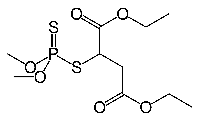 |
| Image 2: Malathion. |
Malathion lotion contains alcohol and terpenoids that may cause stinging. Malathion is considered to be an insecticide with low human toxicity and safe in pregnancy and breastfeeding. Depending on a formulation, weather it’s water or alcohol based it either is or is not safe for use in patients suffering from asthma or epilepsy.
The human nervous system can be divided into two parts: the central nervous system (CNS) and the peripheral nervous system (PNS). The central nervous system (CNS) represents the largest part of the nervous system and includes the brain and the spinal cord. The PNS consists of all other nervous structures that do not lie within the CNS. The large majority of what are commonly called nerves (which are actually axonal processes of nerve cells) are considered to be PNS.
The Peripheral nervous system resides or extends outside the "CNS" central nervous system (the brain and spinal cord) to serve the limbs and organs. Unlike the central nervous system, however, the PNS is not protected by bone, leaving it exposed to toxins and mechanical injuries. The peripheral nervous system is divided into the somatic nervous system and the autonomic nervous system.
The somatic nervous system is responsible for coordinating the body movements, and also for receiving external stimuli. It is the system that regulates activities that are under conscious control. The autonomic nervous system is then split into the sympathetic division, parasympathetic division, and enteric division.
The autonomic nervous system (ANS) (or visceral nervous system) is the part of the peripheral nervous system that acts as a control system, maintaining homeostasis in the body. These maintenance activities are primarily performed without conscious control or sensation. The ANS has far reaching effects, including: heart rate, digestion, respiration rate, salivation, perspiration, diameter of the pupils, micturition (the discharge of urine), and sexual arousal. Whereas most of its actions are involuntary, some ANS functions work in tandem with the conscious mind, such as breathing. Its main components are its sensory system, motor system (comprised of the parasympathetic nervous system and sympathetic nervous system), and the enteric nervous system.
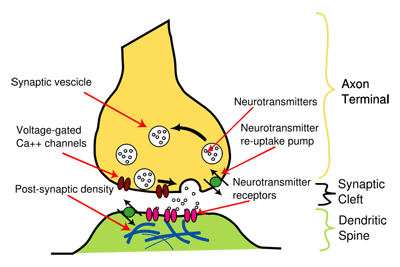 |
| Image 3: Synapse illustration. |
Neurons connect to each other through clefts called synapses. Chemical synapses are specialized junctions through which the cells of the nervous system signal to each other and to non-neuronal cells such as those in muscles or glands. Simply put it synapses are connections between neurons through which nervous impulses pass. They are thus crucial to the biological computations that underlie perception and thought and provide the means through which the nervous system connects to and controls the other systems of the body.
As such they are vitally important to the normal functioning of the body including thought, memory, emotions and the control of all bodily organs like muscles, liver, kidneys, bladder, etc. It is here that many medicines and toxins work to either restore or disrupt the normal balance of biological chemicals called neurotransmitters that control the signal transmission from one neuron to another.
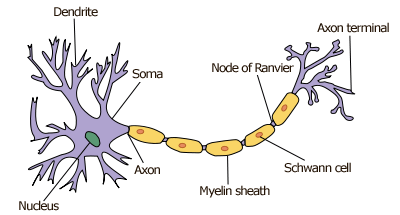 |
| Image 4: A neuron. |
Ganglia or ganglion is a tissue mass, composed mainly of somata (nervous cell bodies) and dendritic structures (branched projections of a neuron that act to conduct the electrical stimulation received from other neural cells to the cell body). Ganglia provide relay points and intermediary connections between different neurological structures in the body, such as the peripheral and central nervous systems.
Basic (two-neuron) pattern of the sympathetic and parasympathetic system consists of preganglionic neurons with cell bodies within the central nervous system (CNS) and postganglionic neurons with cell bodies in the autonomic ganglion.
Parasympathetic system is connected to the CNS via sacral and cranial nerve (III, VII, IX, X) outflow. Its ganglia usually lie close to or within the target organ. Sympathetic outflow leaves the CNS in the thoracic and spinal roots. Sympathetic ganglia form two paravertrebal chains and some midline ganglia.
In both systems (parasympathetic and sympathetic) the neurotransmitter in preganglionic synapses is acetylcholine, which is also the neurotransmitter in postganglionic synapses of parasympathetic system. In postganglionic synapses of the sympathetic system the neurotransmitter is noradrenalin. Sympathetic and parasympathetic systems have opposing actions in some situations (e.g. control of the heart rate, gastrointestinal smooth muscle) but not in others (e.g. salivary glands, ciliary muscle). Both systems exert a continuous physiological control of the specific organs under normal conditions. When the body is in extreme situations one of the systems predominates:
- sympathetic system: stimulation of this nervous system causes what is known as “fight or flight” response. These effects include increased rate and force of heart contraction, a rise in blood pressure, a shift of blood flow to skeletal muscles, dilatation of bronchioles and pupils, and an increase in blood glucose levels.
- parasympathetic system: stimulation of this system is known as “rest or digest”. Its role is restoration and conservation of energy, as it causes a reduction in heart rate and blood pressure. Active parasympathetic system facilitates digestion and absorption of nutrients.
Acetylcholine (2-acetoxy-N,N,N-trimethylethanaminium) is a neurotransmitter. It is an ester of acetic acid and choline with a chemical formula CH3COOCH2CH2N+(CH3)3. Its effects depend on the type of the receptor it binds to. There are two known types of receptors:
Muscarinic receptors (mAChR): There are three subtypes:
a.) M1-receptors: are found mainly on CNS and peripheral neurons and gastric parietal cells. They mediate excitatory effects, which are produced by a decrease in K+ conductance that causes membrane polarization .This receptors are also involved in the increase of gastric acid secretion following vagal stimulation.
b.) M2-receptores: occur in the heart and on the presynaptic terminals of peripheral and central neurons. Activation of this receptors is responsible for the vagal inhibition of the heart (decrease in cardiac rate and force of contraction), as well as presynaptic inhibition in the CNS and periphery.
c.) M3-receptores: activation of this subtype leads to stimulation of glandular secretions and contraction of visceral smooth muscle.
Nicotinic receptors (nAChR): they are directly coupled to cation channels and mediate fast excitatory synaptic transmission. There are three subtypes:
a.) muscle receptors: are located in skeletal neuromuscular junctions.
b.) ganglionic receptors: are responsible for transmission at sympathetic and parasympathetic ganglia.
c.) CNS-type receptors: are mainly in the brain.
Acetylcholinesterase is an enzyme that hydrolyzes the acetylcholine at neuromuscular junctions and brain cholinergic synapses and thus terminates signal transmission of acetylcholine. There are three types of drugs that inhibit acetylcholinesterase:
a.) short acting anticholinesterases: only important drug is Edrophonium which is used mainly for diagnosing myasthenia gravis. This drug has too short acting time for therapeutic use.
b.) medium-duration anticholinesterases: include neostigmine and pyridostigmine, which are used orally in treatment of myasthenia gravis, and physostigmine, which occurs naturally in the Calabar bean (this drug is in eye drops for treatment of glaucoma).
c.) irreversible anticholinesterases: are pentavalent phosphorus compounds containing labile group such as fluoride or an organic group. Most of this organophosphate compounds were developed as war gases (e.g. sarin, VX, ...) and pesticides (e.g malathion, parathion, diazinon, ...) as well as for clinical use (e.g. ecothiopate).
 |
| Image 5: VX gas formula. |
These drugs phosphorylate acetylhcholinesterases and lead to inactivation of the enzyme. The phosphorylated enzyme is usually very stable and cannot be spontaneously regenerated. Irreversible anticholinesterases cause a paralysis through a depolarisation block, which is associated with the build-up of acetylcholine in the plasma and tissue fluids. As an antidote for poisoning by organophosphates and nerve gases usually atropine is used. It is given as an antidote to SLUDGE (= Salivation, Lacrimation, Urination, Diaphoresis, Gastrointestinal motility, Emesis) symptoms caused by organophosphate poisoning. Atropine is a muscarinic receptor antagonist that inhibits excessive effects of acetylcholine. Atropine is usually used in conjunction with pralidoxime chloride, which reactivates acetylcholineesterases by transfer of the phosphate group.
Parasympathomimetics are substances that stimulate or mimic parasympathetic nervous system. There are also known as cholinergics. Chemicals in this group can act either directly by stimulating nicotinic and muscarinic receptors (e.g. nicotine, muscarin, pylocarpine, carbachol) or indirectly by inhibition of acetylcholinesterases (e.g. neostigmine, physostigmine).
LINDANE
is a synthetic chemical which works by interfering with the GABA neurotransmitter function of parasites. Use of this substance is limited because of its potential neurotoxicity. In some cases seizures have been reported, but they are rare and have almost always resulted from improper use and oral ingestion. Lindane products are applied for only four minutes to wet the hair and skin of the affected area and surrounding areas. Treatment may be repeated after 7 days, if necessary. This substance should be avoided in pregnancy and breastfeeding.
GABA or gamma-aminobutyric acid is an inhibitory neurotransmitter in many different CNS pathways. GABA acts on two distinct types of receptor:
a.) GABAA receptors: occure mainly postsynaptically and are directly coupled to chloride channels, opening of which leads to hyperpolarization of the cell and thus reduces membrane excitability.
b.) GABAB receptors: are G-protein-coupled receptors, linked to inhibition of cAMP formation. They cause pre- and post-synaptic inhibition by inhibiting calcium channel opening and increasing K+ conductance.
Drugs that act as agonists of GABA receptors or increase the available amount of GABA typically have a relaxing, anti-anxiety and anti-convulsive effects. The most famous of these are benzodiazepines, i.e. diazepam (Valium) and alprazolam (Xanax).
In order to understand the meaning of hyperpolarization, depolarisation etc. we must first explain that a living cell in electrically charged. This charge comes from the difference in the concentrations of electrically positive and negative ions inside and outside of the cell i.e. potassium (K+), sodium (Na+), chlorine (Cl-). This creates a so called electrochemical concentration differential or gradient across the cell membrane. The maintenance of this electrical gradient is due to various ion pumps and exchange mechanisms, including the Na+-K+ ion exchange pump, the Na+-Ca2+ exchanger current and the IK1 inwardly rectifying K+ current. Intracellularly (within the cell), K+ is the principal cation, and phosphate and the conjugate bases of organic acids are the dominant anions. Extracellularly (outside the cell), Na+ and Cl- predominate. Without getting into too much detail, it is this difference in the intra and extra cellular concentrations of mostly sodium and potassium ions that keeps the cell electrically charged at a so called resting potential of -70 mV.
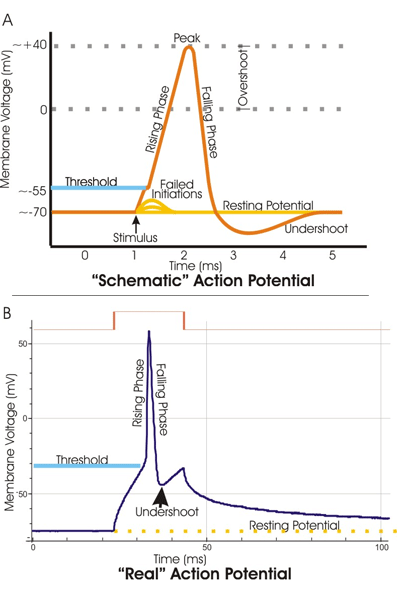 |
| Image 6: Action potential chart. |
When the membrane of an excitable cell becomes depolarized beyond a threshold, the cell undergoes an action potential. A local membrane depolarization caused by an excitatory stimulus causes some voltage-gated sodium channels in the neuron cell surface membrane to open, causing sodium ions to rush in at high speed through the channels along their electrochemical gradient. Because they are positively charged, they begin a reversal in the potential difference across the membrane. A rather complex reaction involving sodium and potassium channels follows to reverse the depolarisation and restore the normal resting potential. The potential which peaks at around +55 mV is called action potential because it usually results in some form of biological action i.e. release of neurotransmitter.
Cell membranes are full of complex protein molecules that act as channels for different ions and are mostly voltage-gated or ligand-gated, meaning that they are controled by either voltage or specific ligand molecules respectively. This is important to remember as they control the resting potential of a cell and can make it more or less excitable. Many epilepsy drugs work on ion channels i.e. allowing more electro negative chlorine (Cl-) ions to enter the cells, thus hiperpolarising the neuron cells, making them harder to excite (depolarise to the threshold potential) and thus trigger an epileptic fit.
Another interesting group of ion channels are the two voltage-dependent calcium channels that play critical roles in the physiology of cardiac muscle (myocardium): L-type calcium channel ('L' for Long-lasting) and T-type calcium channels ('T' for Transient) voltage-gated calcium channels. A group of drugs called calcium channel blockers work by blocking L-type voltage-gated calcium channels (VGCCs) resulting in a decreased force of contraction of the myocardium (negative inotropic effect), slower conduction of electrical activity within the heart (negative dromotropic effect) and lower heart rate (negative chronotropic effect).
PERMETHRIN
is a synthetic chemical that belongs to the family of synthetic chemicals called pyrethroids. It works by prolonging the activation of sodium channels in neuron membranes and is used as an insecticide, acaricide and as an insect repellent.
 |
| Image 7: Permethrin formula. |
Sodium channels are integral membrane proteins that form ion channels, conducting sodium ions through a cell’s plasma membrane. They can be classified according to the trigger that opens the channel:
- voltage-gated sodium channels: this channels open when a voltage change occurs. They are crucial for the propagation of action potentials in excitable membranes. These channels cause the cell membrane to depolarise by allowing the influx of sodium ions into the cell.
- ligand-gated sodium channels: are activated by binding of a ligand. They are found in the neuromuscular junction as nicotinic receptors, where the ligands are acetylcholine molecules.
Substances that act on this type of channels can activate or block them:
a.) Activators:
- alkaloid based toxins (veratridine, batrachotoxin, aconitine)
- diterpene based toxins (grayanotoxin)
b.) Blockers:
- extracellular: tetrodotoxin - this toxin leads to death by respiratory paralysis, puffer fish is well known for production of this toxin.
- intracellular: on this channels act some local anaesthetics, class I anti-arrhythmic agents and some anticonvulsants.
Permethrin is used as 1% cream rinse that is left on scalp and hair for 10 minutes. If the first application fails to kill the eggs, you should make a second treatment after 7 days. If it fails again there is no point in a third application, because it will only contribute to the resistance of head lice towards the drug that has already been developed due to its wide use in agriculture.
PYRETHRINS are organic compounds that attack nervous system of all insects. The product containing this compound is applied to the hair until wet and leaving it on for 10 minutes. A second application is required after 7 to 10 days.
ALTERNATIVE TREATMENT
If you prefer to avoid chemicals in the treatment of head lice, there are some non-chemical products available that are based on natural oils. One that is often used is coconut oil. It works by surrounding the louse in an oily film which blocks its access to air.
Another very popular herbal treatment is tea tree oil. This is a membrane-active biocide with the main active component being terpinen 4-ol. The data presented in some studies reveal that tea tree oil may be an effective novel agent for the treatment of head lice and scabies.
Most of treatments with oils must be combined with smothering or wet combing methods to be effective.
WET COMBING OR BUG BUSTING
It is difficult to say whether this is a good method, because it seems to work for only about one third of people. I would appear that the success depends mainly on how committed you are to carrying out this treatment properly.
This is a mechanical method with which you comb off lice with a fine toothed comb. The comb should not have spaces between the teeth more than 0.3 mm (0.01 inch). It is better to use a metal comb than a plastic one, because it is less flexible and more effective for multiple uses. There is also a special one available called Nitty Gritty Nit Free Head Lice Comb, with micro-grooved stainless steel teeth, which claim to be more effective, by damaging lice and eggs with the sharp edges of the grooves. If you choose this method, you should follow these steps:
First comb through wet hair with an ordinary comb to get rid of knots and tangles. Some suggest that you should wash the hair with cold water before wet combing, as low temperatures supposedly slow lice down making it is easier to remove them.
- Apply conditioner or olive oil to make it easier to comb through the hair with the fine toothed comb.
- Comb through every bit of hair, pulling the comb from the scalp to the hair ends. The lice that you find, rinse off the comb. Work through the hair at least twice. When you finish rinse out the conditioner.
- Do this every three to four days to make sure you catch any new lice that may have hatched since the previous combing.
- Repeat this procedure until you no longer find any lice at least two times in a row.
PRODUCTS AVAILABLE FOR TREATING HEAD LICE
HEDRIN LOTION
Description: odourless and colourless silky solution. Spreads easily, making it simple to apply. It’s skin friendly and feels like a cosmetic hair conditioner. Hedrin is suitable for adults and children over 6 months.
Active ingredients: dimeticone and cyclomethicone. The lotion kills lice by non-chemical action. It encapsulates the lice and prevents the excretion of water and so smothers them. It is less effective against eggs though and the treatment should be repeated after 7 days!
Because of its mode of action, the advantage of Hedrin is that head lice can not become resistant to it. Dimethicone is chemically a silicon-based organic polymer (polydimethylsiloxane) and can also be used orally for the treatment of bloating and colic in adults and babies (as a special oral formulation).
Treatment: apply to dry hair until it is fully covered with the lotion from roots to tip. Leave it on for 8 hours or over the night and then wash it out. Because Hedrin kills only live lice but not their eggs, it must be used again after 7 days to kill the newly hatched lice.
Warning: It is not recommended for children under 6 months or for people who are sensitive to silicone.
PRIODERM LOTION
Active ingredient: malathion (0.5% w/v). It disrupts vital metabolic processes in the parasites and ultimately leads to their death. Prioderm lotion kills lice and their eggs.
Treatment: the lotion should be applied to the scalp and rubbed into dry hair from roots to the tips until all the hair is moistened. Leave the hair to dry naturally (do not use a hairdryer). After 10 to 12 hours shampoo the hair. Rinse the hair and comb it with a fine toothed metal comb while still wet to remove dead lice and eggs. Because the insecticide liquid may not penetrate the egg’s shell, it may be necessary to repeat the treatment after 7 days.
Warning: Prioderm contains alcohol and should be used with caution in people with asthma (it may cause wheezing), eczema (it may cause skin irritation) or sensitive skin (it may cause stinging or skin irritation). The lotion should not be used for children under 6 months of age (except on medical advice). Keep medication away from fire or flames. The medicine is not known to be harmful if used during pregnancy or breastfeeding.
DERBAC M LIQUID
Active ingredient: malathion. It disrupts vital metabolic processes in the parasites and ultimately leads to their death. Derbac M liquid kills lice and their eggs (nits). This product is water-based and therefore suitable for people with asthma and eczema.
Treatment: apply to dry hair from roots to the tips until the hair is completely moistened. Leave the hair to dry naturally (do not use a hairdryer). After 10 to 12 hours shampoo the hair. Rinse the hair and comb it with a fine toothed metal comb while still wet to remove the dead lice and eggs. Because the insecticide liquid may not penetrate the egg’s shell, it may be necessary to repeat the treatment after 7 days.
Warnings: not to be used in infants under 6 months of age (except on medical advice). The product is not known to be harmful if used during pregnancy or breastfeeding if used as recommended.
FULL MARKS SOLUTION
Active ingredients: cyclomethicon and isopropyl mirsitate. These two ingredients smother the lice.
Treatment: first comb the hair, then apply the solution to dry hair and leave it on for 10 minutes. Then comb the hair with a metal comb provided to remove dead lice and eggs. At the end wash out the solution with a non-conditioning shampoo. Repeat the process after 7 days to ensure that eggs which were missed in the first treatment are now removed.
Warning: can be used on adults, elderly and children over 2 years old. There are no special precautions required when using this product (it is suitable for people with asthma and eczema). It may leave hair very oily though and it might take a few washes to completely remove it.
LICE ATTACK
Active ingredient: coconut oil derivates. This product works in a non-chemical way. It coats the lice cutting off their air supply, causing them to suffocate. It also dissolves the substance that glues the nits to hair so it is easier to comb them off.
Treatment: apply the shampoo to dry hair and then massage the shampoo all over the scalp for 5 minutes. Leave it on for at least another 15 minutes to take effect. Then rinse the shampoo and comb wet hair with provided comb. Repeat this treatment after 7 and 14 days to make sure that the life cycle of the head lice is completely broken.
Warnings: the product should not be used if the infected person is sensitive to any of the ingredients. Lice attack can be used during pregnancy and breastfeeding.
LYCLEAR SPRAY AWAY
Active ingredients: caprylic/capric triglyceride (fractionated coconut oil), isopropyl alcohol, Illicium verum (anise) Oil, Cananga odorata (Ylang-Ylang) flower oil. Lyclear Spray Away has non-chemical mode of action. It smothers the lice and dissolves the glue that attaches nits to hair, making it is easier to comb them off. The ylang-ylang oil helps to soothe irritation caused by lice saliva and scratching.
Triglyceride (also known as triacylglycerol or triacylgliceride or lipid or simply fat or oil) is a glyceride in which the glycerol is esterified with three fatty acids. The chemical formula is RCOO-CH2-CH(-OOCR’)-CH2OOCR’’, where R, R’ and R’’ are long alky chains. The three fatty acids (RCOOH, R’COOH and R’’COOH) can be all same, all different, or two can be the same. Chain lengths of the fatty acids in naturally occurring triglycerides can be of varying lengths but 16 (palmitic, palmitoleic), 18 (stearic, oleic, linoleic [LA], alpha-linolenic [GLA]) and 20 (arachidic, arachidonic [AA], eicosapentaenoic [EPA]) carbon atoms are the most common. It is these fatty acids that determine whether a fat is liquid or solid at room temperature and perhaps more importantly whether it is good or bad for your health.
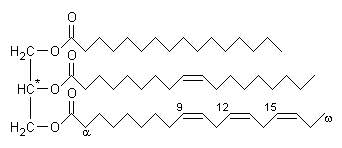 |
| Image 8: An example of a triglyceride. |
Fatty acids are extremely important to human health and will be covered in a separate article. Perhaps just one interesting note at this point. Arachidonic acid is an important component of cell membranes in the form of phospholipids. When a cell is damaged arachidonic acid is released from the membrane by enzymes called phospholipases and is then converted by cyclooxygenases (COX) and lipooxygenases into prostaglandins and leukotrienes respectively. Prostaglandins and leukotrienes are the two major inflammatory mediators implicated in acute conditions such as pain and swelling from injuries and chronic diseases such as atherosclerosis, allergic rhinitis and rheumatoid arthritis. As these diseases represent a huge public health burden, they have been a very popular target for pharmaceutical drug development. A vast array of non-steroidal anti-inflammatory drugs (NSAIDs), targeting the COX group of enzymes have been developed and recently a leukotriene receptor antagonist montelukast (Singulair) was developed for the treatment of seasonal allergies.
Treatment: spray Lyclear Spray Away all over dry hair until it is lightly wetted. Then massage the lotion into the hair for a minute and leave it on for at least 15 minutes to take effect. After that time wash the hair as normal and then comb wet hair with provided lice comb. To make sure that all lice are eliminated repeat the treatment after 7 days.
Warnings: the spray should not be used on children under two years and on people allergic to any of the ingredients. The product contains flammable components and should not be used near any source of heat.
LYCLEAR CREAM RINSE
Active ingredient: permethrin (1% w/w). This component paralyses the nervous system and ultimately leads to the death of the lice.
Treatment: wash the hair with a mild shampoo, which should not contain a conditioner and then apply the cream rinse to the hair until it is completely saturated. Leave it on for 10 minutes and then rinse it off. Comb wet hair with the comb provided.
Warnings: it should not be used on children under 6 months and during pregnancy or breastfeeding. Some of the components may not be suitable for people with asthma or eczema.
QUIT NITS HEAD LICE ELIMINATOR
Active ingredients: lavender oil, geranium oil, santalum spicatum, heartwood oil essential. This product has a paralysing effect on lice and also prevents eggs from hatching. The paralysis occurs within 10 minutes. After that time they can no longer cling to the hair shaft and are easily removed with included comb. Paralysis lasts for 1 hour. Lice that are missed during combing can be removed when hair is washed at the end of the treatment.
Treatment: massage product into the dry hair until it is wet and leave it to effect for 10 minutes. Then comb the hair with included comb. After combing wash the hair with a regular shampoo. Repeat the treatment after 7 days.
Warnings: the product should not be used if you are sensitive to any of the components. Quite nits eliminator is safe to use during pregnancy and breastfeeding.
QUIT NITS HEAD LICE DEFENCE SPRAY
Active ingredients: geranium oil, lavender oil, eucalyptus oil, santalum spicatum heartwood oil. This product prevents head lice re-infestation. It has no effect what so ever on living lice or nits.
Treatment: lightly spray Quit Nits Head Lice Defence Spray onto dry hair and then comb them with a regular comb or brush. For best results, repeat daily or as often as required.
Warnings: this product is NOT effective when living lice or nits are detected (in that case use another product!). Do not use Quit Nits Head Lice Defence Spray if you are sensitive to any of the components. It is safe to use during pregnancy and breastfeeding.
NICE’N CLEAR
Active ingredients: neem seed oil, tea tree leaf oil, lavender oil, nettle extract, thyme extract. This product improves the effectiveness of the wet combing regime.
Treatment: wash the hair with normal shampoo and towel dry. Apply Nice’n Clear with your fingertips to the scalp so it is evenly covered. First brush the hair with a normal comb to remove tangles. Then comb the hair with a lice comb. After removing all visible lice and eggs dry the hair naturally. Repeat the treatment after 7 and 14 days.
Warnings: it should not be used on children under 6 months of age. This product is suitable for people with asthma and those who have sensitive skin. Don’t use the lotion if you are allergic to any of the components.
HEAD LICE FACTS
- Lice don’t swim, jump or fly. They can only walk from head to head.
- Lice like any kind of hair (short, long, clean, dirty).
- They feed every 4-6 hours with human blood.
- Head lice live only on human heads.
- Short hair is no protection from head lice (except if shorter than 1 inch).
- To diagnose head lice infection you have to see a live louse. Nits do not necessarily mean that you are infected.
- Chemical products should not be used as a preventive.
- Many no-chemical alternatives are available.
- If you tried a treatment two times and it did not work, it may be because of incorrect usage of the product or because a re-infestation occurred. If you used a chemical product the reason of inefficiency may be resistance towards the active component.
SUMMARY
These tiny parasites are not dangerous, nor do they spread any diseases. They are just annoying and unsightly. Head lice like any kind of hair and are therefore not a sign of poor hygiene. To diagnose the infestation you have to see a live louse, because nits may still be there from a previous infestation. If you have children, you should examine their hair every now and then, because not everyone develops the symptoms. When you diagnose the infection you have many products to treat it. Products work chemically (permethrin, malathion, ...) or in a non-chemical way (dimeticone, essentials oils,...). If you still detect head lice after two treatments it may be because of resistance, improper use or because a re-infestation occurred. If you have any questions consult your doctor or pharmacist.
- Printer-friendly version
 Delicious
Delicious Digg
Digg Facebook
Facebook Google
Google- 103898 reads

Check-Treat-Complete
Medical Entomology Centre and RPSGB have put together a great on-line tutorial based on the most recent best practice guidelines and is available at http://www.checktreatcomplete.co.uk/online-training/
Post new comment